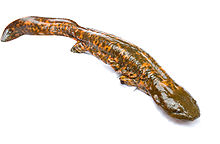
Back هلبندر Arabic هلبندر ARZ کریپتوبرانچوس اللقانینسیس AZB Алеганска скритохрила саламандра Bulgarian Sourd meur Amerika Breton Salamandra gegant americana Catalan Cryptobranchus alleganiensis CEB Velemlok americký Czech Schlammteufel German Amerika giganta salamandro Esperanto
| Hellbender | |
|---|---|

| |
| Scientific classification | |
| Domain: | Eukaryota |
| Kingdom: | Animalia |
| Phylum: | Chordata |
| Class: | Amphibia |
| Order: | Urodela |
| Family: | Cryptobranchidae |
| Genus: | Cryptobranchus Leuckart, 1821 |
| Species: | C. alleganiensis
|
| Binomial name | |
| Cryptobranchus alleganiensis (Daudin, 1803)
| |
| Subspecies | |
| |

| |
| Distribution of the eastern hellbender (Ozark hellbender not shown) | |
| Synonyms | |
|
List
| |
The hellbender (Cryptobranchus alleganiensis), also known as the hellbender salamander, is a species of aquatic giant salamander endemic to the eastern and central United States. It is the largest salamander in North America. A member of the family Cryptobranchidae, the hellbender is the only extant member of the genus Cryptobranchus. Other closely related salamanders in the same family are in the genus Andrias, which contains the Japanese and Chinese giant salamanders. The hellbender, which is much larger than all other salamanders in its geographic range, employs an unusual means of respiration (which involves cutaneous gas exchange through capillaries found in its lateral skin folds), and fills a particular niche—both as a predator and prey—in its ecosystem, which either it or its ancestors have occupied for around 65 million years. The species is listed as Vulnerable on the IUCN Red List of Threatened Species due to the impacts of disease and widespread habitat loss and degradation throughout much of its range.[2]
- ^ Bredehoeft, Keila E.; Schubert, Blaine W. (2015). "A Re-Evaluation of the Pleistocene Hellbender, Cryptobranchus guildayi ". Journal of Herpetology. 49: 157–160. doi:10.1670/12-222. S2CID 84731832.
- ^ a b IUCN SSC Amphibian Specialist Group (2022). "Hellbender". IUCN Red List of Threatened Species. 2022. Retrieved 9 December 2022.
- ^ Listed by United States of America
- ^ Dundee, Harold A. (1971). "Cryptobranchus alleganiensis ". Catalogue of American Amphibians and Reptiles. American Society of Ichthyologists and Herpetologists. Account 101.
- ^ Cite error: The named reference
Nickwas invoked but never defined (see the help page). - ^ Stejneger L, Barbour T (1917). A Check List of North American Amphibians and Reptiles. Cambridge, Massachusetts: Harvard University Press. 125 pp. (Cryptobranchus alleganiensis, p. 7).
© MMXXIII Rich X Search. We shall prevail. All rights reserved. Rich X Search
